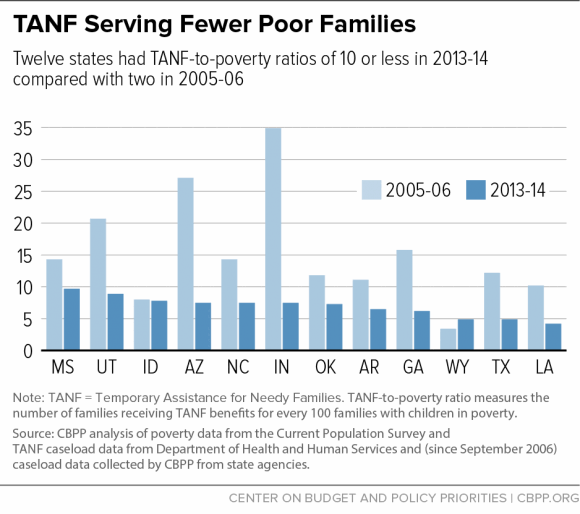más allá de los números
States Increasingly Weakening TANF as Safety Net
With a Senate Finance Committee hearing today on U.S. welfare and poverty, policymakers should know that states are increasingly using their flexibility under Temporary Assistance for Needy Families (TANF) to weaken TANF as a safety net program — making clear that state flexibility has not improved the lives of America’s poorest families.
As I wrote yesterday and we detail in our updated paper, for every 100 families with children in poverty across the country, just 23 families received TANF cash assistance in 2014, down from 68 when President Clinton and Congress created TANF in 1996 to replace Aid to Families with Dependent Children. Moreover, this TANF-to-poverty ratio (TPR) varies widely among states, ranging from a low of 4 in Louisiana to a high of 78 in Vermont. In 12 states, the ratio is 10 or less (see chart).

In this blog, we focus more on the specific policy, process, and budget decisions that, with their legal flexibility, states have made that have substantially weakened TANF’s role as a safety net program — even as many families’ need for cash assistance rose during and after the recession. In December 2014, 37 states’ TANF caseloads had fallen below their December 2006 levels.
Some states shortened or otherwise changed their time limits. Others made administrative changes such as imposing more stringent applicant requirements that made it harder for families to qualify for benefits. Some states made these changes to free up funds to fill budget holes, while others did so for ideological reasons.
For example:
- Arizona reduced the TANF time limit from 60 to 36 months in 2010 and then to 24 months in 2011. Also in 2010, Arizona terminated many child-only cases because it began to factor in the income of the relatives caring for children (even when these relatives were not seeking assistance for themselves) and instituted time limits on these child-only cases. These changes account for the majority of the two-thirds drop in Arizona’s TANF caseload between December 2006 and December 2014. (The state enacted a third time limit cut in 2015, and it will reduce the lifetime limit to 12 months effective in July 2016.)
- Indiana has changed its policies and procedures around work requirements, including by changing sanction penalties and requiring applicants to complete 20 days of job searching before the state will approve benefits. Indiana’s caseload plummeted after these changes and dropped by 77 percent between December 2006 and December 2014.
Many states’ changes to their TANF programs have left more families deeply poor and without the resources to meet their most basic needs. TANF’s track record shows that state flexibility hasn’t measurably improved poor families’ lives.

